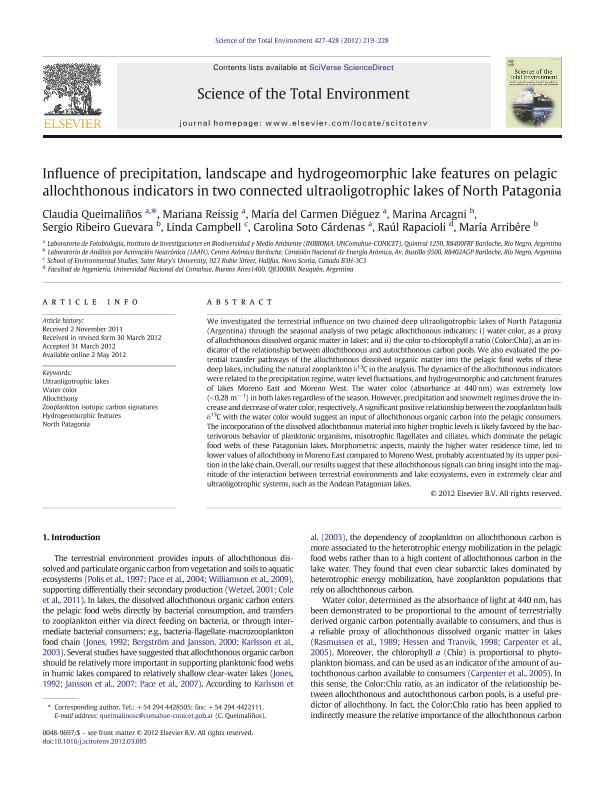Mostrar el registro sencillo del ítem
dc.contributor.author
Queimaliños, Claudia Patricia

dc.contributor.author
Reissig, Mariana

dc.contributor.author
Dieguez, Maria del Carmen

dc.contributor.author
Arcagni, Marina

dc.contributor.author
Ribeiro, Sergio

dc.contributor.author
Campbell, Linda
dc.contributor.author
Soto Cárdenas, Estela Carolina

dc.contributor.author
Rapacioli, Raúl
dc.contributor.author
Arribere, Maria Angelica

dc.date.available
2019-03-11T20:04:26Z
dc.date.issued
2012-07
dc.identifier.citation
Queimaliños, Claudia Patricia; Reissig, Mariana; Dieguez, Maria del Carmen; Arcagni, Marina; Ribeiro, Sergio; et al.; Influence of precipitation, landscape and hydrogeomorphic lake features on pelagic allochthonous indicators in two connected ultraoligotrophic lakes of North Patagonia; Elsevier Science; Science of the Total Environment; 427-428; 7-2012; 219-228
dc.identifier.issn
0048-9697
dc.identifier.uri
http://hdl.handle.net/11336/71391
dc.description.abstract
We investigated the terrestrial influence on two chained deep ultraoligotrophic lakes of North Patagonia (Argentina) through the seasonal analysis of two pelagic allochthonous indicators: i) water color, as a proxy of allochthonous dissolved organic matter in lakes; and ii) the color to chlorophyll a ratio (Color:Chla), as an indicator of the relationship between allochthonous and autochthonous carbon pools. We also evaluated the potential transfer pathways of the allochthonous dissolved organic matter into the pelagic food webs of these deep lakes, including the natural zooplankton δ 13C in the analysis. The dynamics of the allochthonous indicators were related to the precipitation regime, water level fluctuations, and hydrogeomorphic and catchment features of lakes Moreno East and Moreno West. The water color (absorbance at 440nm) was extremely low (<0.28m -1) in both lakes regardless of the season. However, precipitation and snowmelt regimes drove the increase and decrease of water color, respectively. A significant positive relationship between the zooplankton bulk δ 13C with the water color would suggest an input of allochthonous organic carbon into the pelagic consumers. The incorporation of the dissolved allochthonous material into higher trophic levels is likely favored by the bacterivorous behavior of planktonic organisms, mixotrophic flagellates and ciliates, which dominate the pelagic food webs of these Patagonian lakes. Morphometric aspects, mainly the higher water residence time, led to lower values of allochthony in Moreno East compared to Moreno West, probably accentuated by its upper position in the lake chain. Overall, our results suggest that these allochthonous signals can bring insight into the magnitude of the interaction between terrestrial environments and lake ecosystems, even in extremely clear and ultraoligotrophic systems, such as the Andean Patagonian lakes. © 2012 Elsevier B.V.
dc.format
application/pdf
dc.language.iso
eng
dc.publisher
Elsevier Science

dc.rights
info:eu-repo/semantics/openAccess
dc.rights.uri
https://creativecommons.org/licenses/by-nc-sa/2.5/ar/
dc.subject
Allochthony
dc.subject
Hydrogeomorphic Features
dc.subject
North Patagonia
dc.subject
Ultraoligotrophic Lakes
dc.subject
Water Color
dc.subject
Zooplankton Isotopic Carbon Signatures
dc.subject.classification
Meteorología y Ciencias Atmosféricas

dc.subject.classification
Ciencias de la Tierra y relacionadas con el Medio Ambiente

dc.subject.classification
CIENCIAS NATURALES Y EXACTAS

dc.subject.classification
Otras Ciencias Biológicas

dc.subject.classification
Ciencias Biológicas

dc.subject.classification
CIENCIAS NATURALES Y EXACTAS

dc.title
Influence of precipitation, landscape and hydrogeomorphic lake features on pelagic allochthonous indicators in two connected ultraoligotrophic lakes of North Patagonia
dc.type
info:eu-repo/semantics/article
dc.type
info:ar-repo/semantics/artículo
dc.type
info:eu-repo/semantics/publishedVersion
dc.date.updated
2019-03-08T16:48:17Z
dc.journal.volume
427-428
dc.journal.pagination
219-228
dc.journal.pais
Países Bajos

dc.journal.ciudad
Amsterdam
dc.description.fil
Fil: Queimaliños, Claudia Patricia. Consejo Nacional de Investigaciones Científicas y Técnicas. Centro Científico Tecnológico Conicet - Patagonia Norte. Instituto de Investigaciones en Biodiversidad y Medioambiente. Universidad Nacional del Comahue. Centro Regional Universidad Bariloche. Instituto de Investigaciones en Biodiversidad y Medioambiente; Argentina
dc.description.fil
Fil: Reissig, Mariana. Consejo Nacional de Investigaciones Científicas y Técnicas. Centro Científico Tecnológico Conicet - Patagonia Norte. Instituto de Investigaciones en Biodiversidad y Medioambiente. Universidad Nacional del Comahue. Centro Regional Universidad Bariloche. Instituto de Investigaciones en Biodiversidad y Medioambiente; Argentina
dc.description.fil
Fil: Dieguez, Maria del Carmen. Consejo Nacional de Investigaciones Científicas y Técnicas. Centro Científico Tecnológico Conicet - Patagonia Norte. Instituto de Investigaciones en Biodiversidad y Medioambiente. Universidad Nacional del Comahue. Centro Regional Universidad Bariloche. Instituto de Investigaciones en Biodiversidad y Medioambiente; Argentina
dc.description.fil
Fil: Arcagni, Marina. Consejo Nacional de Investigaciones Científicas y Técnicas; Argentina. Comisión Nacional de Energía Atómica. Gerencia del Área de Energía Nuclear. Unidad de Actividad de Ingeniería Nuclear. Laboratorio de Análisis por Activación Neutróica; Argentina
dc.description.fil
Fil: Ribeiro, Sergio. Comisión Nacional de Energía Atómica. Gerencia del Área de Energía Nuclear. Unidad de Actividad de Ingeniería Nuclear. Laboratorio de Análisis por Activación Neutróica; Argentina
dc.description.fil
Fil: Campbell, Linda. School Of Environmental Studies. Saint Mary's University; Canadá
dc.description.fil
Fil: Soto Cárdenas, Estela Carolina. Consejo Nacional de Investigaciones Científicas y Técnicas. Centro Científico Tecnológico Conicet - Patagonia Norte. Instituto de Investigaciones en Biodiversidad y Medioambiente. Universidad Nacional del Comahue. Centro Regional Universidad Bariloche. Instituto de Investigaciones en Biodiversidad y Medioambiente; Argentina
dc.description.fil
Fil: Rapacioli, Raúl. Universidad Nacional del Comahue; Argentina
dc.description.fil
Fil: Arribere, Maria Angelica. Comisión Nacional de Energía Atómica. Gerencia del Área de Energía Nuclear. Unidad de Actividad de Ingeniería Nuclear. Laboratorio de Análisis por Activación Neutróica; Argentina
dc.journal.title
Science of the Total Environment

dc.relation.alternativeid
info:eu-repo/semantics/altIdentifier/url/https://www.sciencedirect.com/science/article/pii/S0048969712004895
dc.relation.alternativeid
info:eu-repo/semantics/altIdentifier/doi/https://doi.org/10.1016/j.scitotenv.2012.03.085
Archivos asociados
